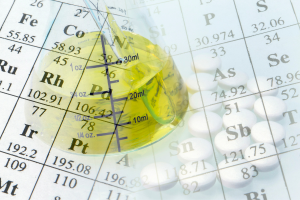One of the criteria by which chemical reactions can be divided is their rate of progression. Broadly generalising, it can be said that, in chemistry, we are dealing with reactions that proceed at high speed (such a process is often visible to the naked eye) and those that proceed so slowly that they are almost imperceptible. The concept of reaction rate is a broad one, requiring a number of factors to be taken into account in order to characterise it correctly.

Reaction rate
The rate at which a chemical reaction proceeds is defined as the change in concentration of the substrate or product over time. The rate of a chemical reaction is a function that is presented in the form of a generally applicable rate equation. Changes in the quantity of components in such an equation are usually expressed in molar concentrations. Please note that any other way of expressing quantity can be used, such as mass, molar fraction, or atomic fraction (ratio). Chemistry also uses a more advanced concept called the instantaneous rate of a chemical reaction. The reaction course can be visualised by plotting the relationship between molar concentration (on the y-axis) and the reaction time (on the x-axis). For the resulting curve, a tangent and its slope are determined, the latter of which corresponds to the instantaneous rate of the reaction.
Another value that also characterises the rate of a chemical reaction is the so-called half-life. It is a value that describes the behaviour of radioactive elements over time. The half-life is the time required for half of the initial amount of substrate to react, which means that the longer the half-life, the smaller the rate constant k in the rate equation of a chemical reaction.
Factors affecting the rate of a chemical reaction:
- Substrate concentration – it has been experimentally proven time and time again that the reaction rate is decisively dependent on the substrate concentration. The higher its concentration in the system, the faster a particular process will proceed. This can be explained using collision theory. According to this theory, a condition for a particular chemical reaction to take place is the occurrence of a successful collision (i.e. collision with sufficient energy) between individual substrate molecules. Thus, the more substrate molecules there are (the higher their concentration), the higher probability of a collision is, and thus the higher reaction rate (this is a directly proportional relationship).
- A catalyst present in the system – catalysts are substances that, when added to a reaction system, increase the rate at which a chemical reaction proceeds. This is related to the reduction of the activation energy, i.e. the energy required for the substrates to overcome the energy barrier of the reaction and form the active complex (the transition state) prior to the formation of the actual reaction products. The lowering of the activation energy by the catalyst means that less energy is required to initiate the chemical reaction.
- Temperature and pressure – according to van’t Hoff’s rule, raising the temperature of the reaction system by 10ᵒC, increases the reaction rate by 2 to 4 times. This relationship allows to estimate the reaction rate if the temperature is increased, but it does not apply to all reactions and in exceptional cases it even leads to a decrease in the reaction rate or to undesirable products. For reactions involving only gaseous substances, the pressure in the system plays a key role. Its increase means the substrate concentration is higher, so that successful collisions between individual molecules occur more efficiently and the reaction rate increases.
- Degree of fineness – chemical reactions involving solid substrates take place on their surface. The larger the surface area of the substance, the faster and more efficient the reaction involving it. Thus, in order to increase this area as much as possible, the substrates are subjected to crushing or grinding. An example is iron powder, which oxidises rapidly in the flame of a torch, an effect that is not observed when heating an iron rod.
- Mixing – mixing has a similar effect on the reaction rate as the degree of fineness. Initiating the movement of molecules in the system leads to their more frequent contact and the formation of reaction products. In surface processes, mixing facilitates the detachment of resultant molecules, e.g. from the surface of the catalyst, thus increasing the access to the active centres for other substrates.

Rate equation
The rate equation can be used to describe the relationships between the rate of a chemical reaction and the concentration of the substrates. Each chemical transformation has a characteristic rate equation. In simplest terms, this relationship can be expressed as the product of the coefficient k (called the reaction rate constant, a value that is constant for a particular chemical reaction at a particular temperature) and the concentration of the substrates. The form of the rate equation depends on the reaction order:
- First-order reactions – the rate depends only on the concentration of the substrate, raised to the first power.
- Second-order reactions – in this case, both reacting components or the stoichiometric coefficient in front of one substrate (e.g. in decomposition reactions) must be included in the rate equation. In such a reaction, the rate will depend on the product of the substrate concentrations.
The examples provided above are the most common, as most chemical reactions are of first or second order. But it should be remembered that reactions of a different order, such as zero order, where the reaction rate does not depend on the concentration of the substrates, are also possible.
The rate equation that is written for a particular chemical reaction depends primarily on its mechanism, i.e. on the sequence of elementary reactions in which the molecules undergo changes. In the case of multi-step mechanism processes the rate of the entire reaction is determined by its slowest step. In such a situation, it is difficult to precisely determine the rate equation, or it can be very complicated. The rate equation is also connected with the concept of the order of a chemical reaction. The order is defined as the sum of the exponents in the rate equation. It determines how many molecules, ions or atoms must participate in a successful collision for a chemical reaction to take place.
Impact of catalysts on the rate of chemical reactions
Catalysts are substances whose presence in a system increases the rate of a chemical reaction. Importantly, they themselves do not react in the processes. Together with substrates, they form so-called active complexes, which are much easier to transform. Once the chemical reaction is complete, the catalyst is regenerated in its original form. The main task of the catalyst is to reduce the activation energy, i.e. the energy that must be supplied for successful collisions between the substrates involved in the reaction to occur. We can distinguish homogeneous catalysis (the catalyst and reactants are in the same physical state), heterogeneous catalysis (the catalyst and reactants are in different physical states – the most common type of catalysis, in which the catalyst is referred to as contact) and autocatalysis (one of the resulting products accelerates further chemical reaction).
Catalysis and catalysts are extremely valuable and important aspects of most industrial processes, most notably those in the chemical industry. Catalysts are used in most technological processes in chemistry, e.g. in the production of nitric (V) acid or sulphuric (VI) acid.